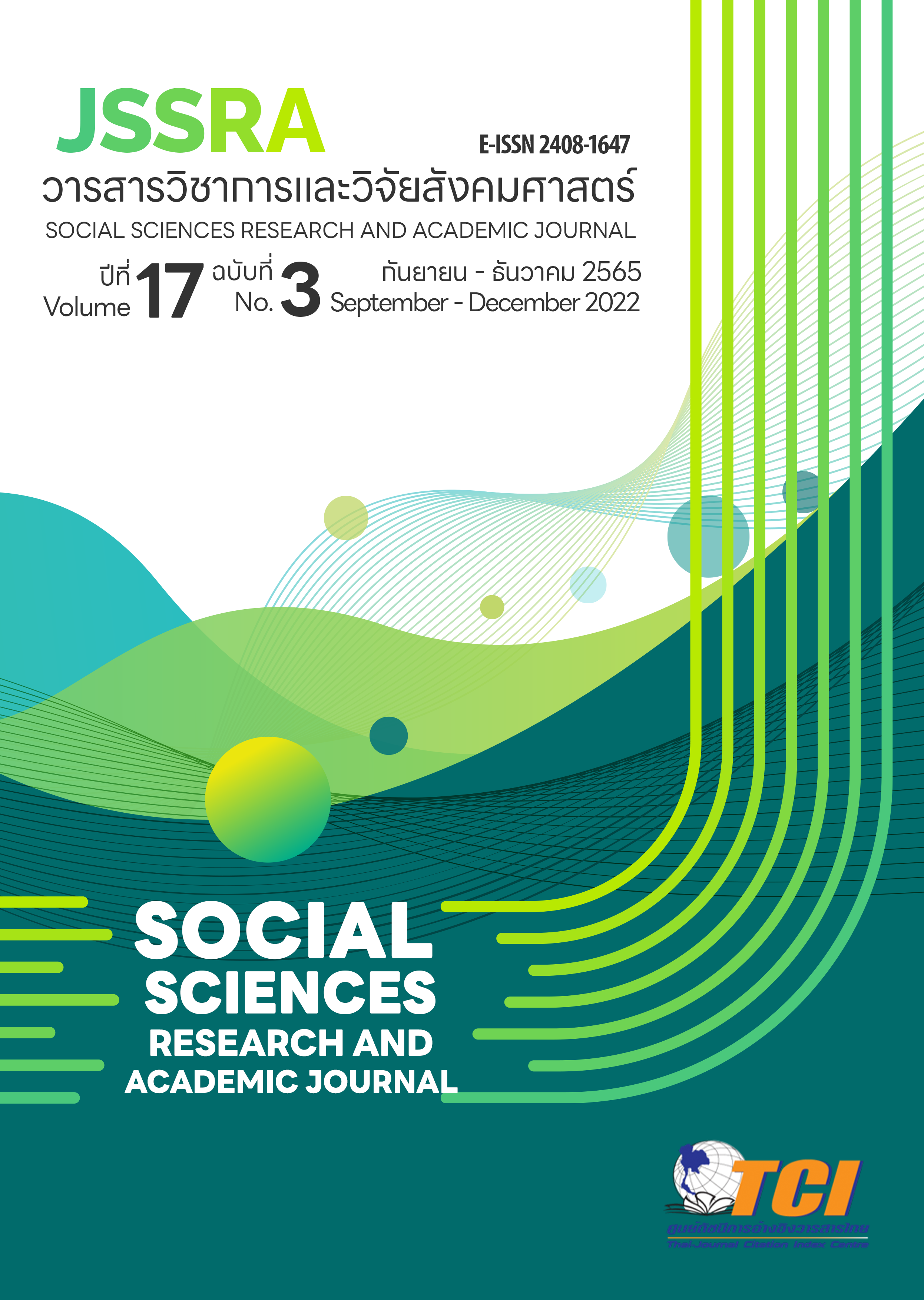การเรียนรู้แบบร่วมมือด้วยเทคนิคจิ๊กซอว์และหนังสือเสริมการอ่านภาษาอังกฤษเพื่อพัฒนาความสามารถด้านการอ่านภาษาอังกฤษของนักเรียนระดับมัธยมศึกษาตอนปลาย Cooperative Learning and English Supplementary Books to Foster English Reading Skills of High School Students
Main Article Content
บทคัดย่อ
บทความวิชาการนี้มีจุดประสงค์ 1) เพื่อศึกษาแนวคิดและทฤษฎีเกี่ยวกับการเรียนรู้แบบร่วมมือด้วยเทคนิคจิ๊กซอว์ แนวคิดทฤษฎีเกี่ยวกับการอ่านแบบกว้างขวาง และความสามารถในการอ่านภาษาอังกฤษและ 2) เพื่อนำเสนอการประยุกต์ใช้การเรียนรู้แบบร่วมมือโดยใช้เทคนิคจิ๊กซอว์และหนังสือเสริมการอ่านภาษาอังกฤษเพื่อพัฒนาความสามารถด้านการอ่านภาษาอังกฤษ โดยมีวิธีการดำเนินโดยการสังเคราะห์ทฤษฎีและแนวคิดที่เกี่ยวข้องเพื่อใช้สร้างแนวทางในการเรียนการสอนเพื่อพัฒนาความสามารถด้านการอ่านภาษาอังกฤษของนักเรียนตัวอย่าง ซึ่งกลุ่มตัวอย่างในบทความนี้คือนักเรียนระดับชั้นมัธยมศึกษาปีที่ 5 จำนวน 30 คน บทความชิ้นนี้สรุปได้ว่าการศึกษาแนวคิดเกี่ยวกับการเรียนรู้แบบร่วมมือ การอ่านแบบกว้างขวางโดยใช้หนังสือเสริมการอ่าน และความสามารถทางการอ่านภาษาอังกฤษ สามารถนำมาซึ่งองค์ความรู้และนำไปสู่การนำเสนอถึงการประยุกต์ใช้การเรียนรู้แบบร่วมมือที่ใช้เทคนิคจิ๊กซอว์และหนังสือเสริมการอ่านภาษาอังกฤษ เพื่อมุ่งพัฒนาความสามารถด้านการอ่านภาษาอังกฤษของนักเรียนระดับชั้นมัธยมศึกษาปีที่ 5 ได้ต่อไป
The purposes of this study were 1) to study the theory of cooperative learning, extensive reading, and reading comprehension and 2) to present the application of the use of cooperative learning with Jigsaw technique and supplementary English books for enhancing matthayom suksa 5 students’ English reading comprehension through synthesis the related theory for planning the application using as learning activities for developing English reading skills of students. The sample is 30 mathayom suksa 5 students. The result can be concluded that the study of the cooperative learning, extensive reading, and reading comprehension theories can be applied to create learning activities for developing English reading skills of mathayom suksa 5 students.
Article Details
เอกสารอ้างอิง
กนิษฐา จีถม. (2550). การใช้กิจกรรมต่อชิ้นส่วนเพื่อส่งเสริมความเข้าใจในการอ่าน การพูดภาษาอังกฤษและทักษะทางสังคมของนักเรียนระดับก้าวหน้า. วิทยานิพนธ์. บัณฑิตวิทยาลัย: มหาวิทยาลัยเชียงใหม่.
กมล โพธิเย็น. (2564). Active Learning : การจัดการเรียนรู้ที่ตอบโจทย์การจัดการศึกษาในศตวรรษที่ 21. วารสารศึกษาศาสตร์ มหาวิทยาลัยศิลปากร, 19(1), 11-28.
กระทรวงศึกษาธิการ. (2551). ตัวชี้วัดและสาระการเรียนแกนกลางกลุ่มสาระการเรียนรู้ภาษาต่างประเทศตามหลักสูตรแกนกลางการศึกษาขั้นพื้นฐาน พุทธศักราช 2551. กรุงเทพฯ: ชุมนุมสหกรณ์แห่งประเทศไทย.
นงค์นาถ ชาววัง. (2551). การสํารวจปัญหาการอ่านภาษาอังกฤษของนักเรียนไทยชั้นมัธยมศึกษาปีที่ 6 เขตพื้นที่การศึกษานครราชสีมา เขต 1, 2, 3 และ 7. ปริญญานิพนธ์. มหาวิทยาลัยศรีนครินทร์วิโรฒ, กรุงเทพฯ.
บำรุง โตรัตน์. (2524). การศึกษาผลของการปริวรรตในประโยคภาษาอังกฤษ ที่มีต่อการอ่านเพื่อความเข้าใจของนิสิตวิชาเอกภาษาอังกฤษ มหาวิทยาลัยศรีนครินทรวิโรฒ พิษณุโลก. วิทยานิพนธ์. มหาวิทยาลัยเกษตรศาสตร์, กรุงเทพฯ.
วิมลรัตน์ สุนทรโรจน์. (2545). เอกสารประกอบการเรียนการสอนวิชาพัฒนาการเรียนการสอน 0506703. มหาสารคาม : มหาวิทยาลัยมหาสารคาม.
ศุภภัทรวริศรา เกตุสุนทร และฉัตรณรงค์ศักดิ์ สุธรรมดี. (2564). การศึกษาในยุค Disruptive Technology. วารสารการบริหารการปกครองและนวัตกรรมท้องถิ่น, 5(3), 73-86.
สมุทร เซ็นเชาวนิช. (2551). เทคนิคการอ่านภาษาอังกฤษเพื่อความเข้าใจ. กรุงเทพฯ: มหาวิทยาลัยธรรมศาสตร์.
สุภาพร ศรศิลป์. (2557). รูปแบบการจัดการเรียนรู้แบบร่วมมือเพื่อพัฒนาทักษะการอ่านภาษาอังกฤษกลุ่มสาระการเรียนรู้ภาษาต่างประเทศสำหรับนักเรียนชั้นมัธยมศึกษาปีที่ 3. นาคบุตรปริทรรศน์, 6(3), 75-85.
อุบลวรรณ พันธุ์พรหม. (2560). การใช้กิจกรรมการอ่านอย่างกว้างขวางเพื่อเพิ่มพูนความสามารถในการอ่านการเขียนและความรู้คําศัพท์ภาษาอังกฤษของนักเรียนชั้นมัธยมศึกษาปีที่ 3. วารสารศิลปากรศึกษาศาสตร์วิจัย 9(2), 363-375.
อำนาจ สมบัติยานุชิต. (2552). การใช้เนื้อหาท้องถิ่นในการเรียนรู้ภาษาแบบร่วมมือเพื่อส่งเสริมความสามารถด้านการพูด การอ่านภาษาอังกฤษและความรู้เกี่ยวกับท้องถิ่นของนักเรียนระดับก้าวหน้า. วิทยานิพนธ์. บัณฑิตวิทยาลัย: มหาวิทยาลัยเชียงใหม่.
Bloom, Benjamin S., et al. (1956). Taxonomy of Educational Objectives. New York: David Mackey Company.
Day, R., & Bamford, J. (1998). Extensive Reading in the Second Language Classroom. Cambridge University Press.
Harmer, J. (1991). The Practice of English Language Teaching. United States of America: Longman.
Iwahori, Y. (2008). “Developing Reading Fluency: A Study of Extensive Reading in EFL”. Reading in a Foreign Language. 20(1): 70-91.
Janthong, J. (2553). Integration Questioning and Extensive Reading to Support English Reading Comprehension and Reading Habit. Unpublished master’s thesis. Prince of Songkla University.
Kagan, S., & Kagan, M. (2009). Kagan Cooperative learning. Kagan Publishing.
Khuhapinant, C. (1999). Reading techniques. Bangkok: Burapasarn.
Masae, K., & Charumanee, N. (2020). The Use of Extensive Reading to Develop English Reading Ability. Kasem Bundit Journal, 21(1), 100-115.
Nation, P. (1997). The Language Learning Benefits of Extensive Reading. The Language Teacher, 21 (5), 69-82. Retrieve December 22, 2001, from http://langue.hyper.chubu.ac.jp/jalt/pub/tlt/97/may/benefits.html
Richards, J. C., & Rodgers, T. S. (2014). Approaches and Methods in Language Teaching. Cambridge university press.
Roger, T., & Johnson, D. W. (1994). An Overview of Cooperative Learning. Creativity and Collaborative Learning, 1-21.
Slavin, R. E. (1995). Cooperative Learning: Theory, Research, and Practice. Boston: Allyn and Bacon.
Udombua, A., & Phusawisot, P. (2019). The Effect of Jigsaw Technique on English Reading Comprehension Skills in Thai Secondary School. Journal of Education, Mahasarakham University, 13(4), 7-24.
Vygotsky, L. S. (1980). Mind in Society: The Development of Higher Psychological Processes. Harvard university press.
Wiederhold, C. (1995). The Q-matrix: Cooperative Learning and Higher Level Thinking. Skylight Professional Development.
Zhu, J., & Adipattaranan, N. (2016). Using Jig¬saw Reading and Semantic Mapping Activities to Develop English Reading and Writing Abilities Among Mathayom Suksa 4 Students.
Veridian E-Journal, Silpakorn University (Humanities, Social Sciences and arts), 9(5), 173-184.


